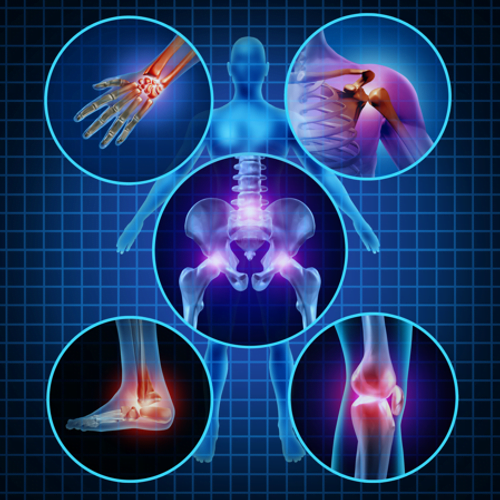About Orthopaedics
Orthopaedics is a medical specialty that focuses on the diagnosis, correction, prevention, and treatment of patients with skeletal deformities – disorders of the bones, joints, muscles, ligaments, tendons, nerves and skin. These elements make up the musculoskeletal system.
The body’s musculoskeletal system is a complex system of bones, joints, ligaments, tendons, muscles and nerves and allows you to move, work and be active. Once devoted to the care of children with spine and limb deformities, orthopaedics now cares for patients of all ages, from new-borns with clubfeet, to young athletes requiring arthroscopic surgery, to older people with arthritis.
Role of the Orthopaedist
Orthopaedist is a doctor who specializes in the branch of medicine concerned with the correction or prevention of deformities, disorders, or injuries of the skeleton and associated structures (specialist in Orthopaedics)
Orthopaedists use medical, physical and rehabilitative methods as well as surgery and are involved in all aspects of health care pertaining to the musculoskeletal system. It is a specialty of incredible breadth and variety. Orthopaedists treat an immense variety of diseases and conditions, including
- Fractures and dislocations
- Torn ligaments
- Sprains and strains tendon injuries
- Pulled muscles
- Bursitis ruptured disks
- Sciatica
- Low back pain
- Scoliosis knock knees
- Bowlegs
- Bunions and hammertoes
- Arthritis and osteoporosis
- Bone tumours
- Muscular dystrophy
- Cerebral palsy
- Club foot
- Unequal leg length abnormalities of the fingers and toes
- Growth abnormalities
In general, Orthopaedists are skilled in the:
- Diagnosis of your injury or disorder
- Treatment with medication, exercise, surgery or other treatment plans
- Rehabilitation by recommending exercises or physical therapy to restore movement, strength and function
- Prevention with information and treatment plans to prevent injury or slow the progression of diseases
While orthopaedic surgeons are familiar with all aspects of the musculoskeletal system, many Orthopaedists specialize in certain areas, such as the foot and ankle, spine, shoulder, hand, hip or knee. They may also choose to focus on specific fields like paediatrics, trauma or sports medicine. Some orthopaedic surgeons may specialize in several areas.
Typically, 50% practice of an Orthopaedist is devoted to non-surgical or medical management of injuries or disease and 50% to surgical management. Surgery may be needed to restore function lost as a result of injury or disease of bones, joint, muscles, tendons, ligaments, nerves or skin.
The Orthopaedist also works closely with other health care professionals and often serves as a consultant to other physicians. Orthopaedists are members of the teams that manage complex, multi-system trauma, and often play an important role in the organization and delivery of emergency care.
Treatments
Orthopaedic patients have benefited from technological advances such as joint replacement, and the arthroscope that allows the Orthopaedist to look inside a joint. But your visit will start with a personal interview and physical examination by our Orthopaedist. This may be followed by diagnostic tests such as blood tests, X-rays, or other tests.
Your treatment may involve medical counselling, medications, casts, splints, and therapies such as exercise, or surgery. For most orthopaedic diseases and injuries, there is more than one form of treatment. Our Orthopaedist will discuss the treatment options with you and help you select the best treatment plan to enable you to live an active and functional life.
Nonsurgical Treatment
Orthopaedic surgeons treat many musculoskeletal conditions without surgery—by using a medication, exercise and other rehabilitative or alternative therapies.
For most orthopaedic diseases and injuries there is more than one form of treatment. If necessary, the orthopaedic surgeon may recommend surgery if you do not respond to nonsurgical treatments.
Surgical Treatment
Orthopaedic surgeons perform numerous types of surgeries. Common procedures include:
- Arthroscopy—a procedure that uses special cameras and equipment to visualize, diagnose and treat problems inside a joint.
- Joint replacement (partial, total and revision)—when an arthritic or damaged joint is removed and replaced with an artificial joint called a prosthesis.
- Fusion—a “welding” process by which bones are fused together with bone grafts and internal devices (such as metal rods) to heal into a single solid bone.
- Internal fixation—a method to hold the broken pieces of bone in proper position with metal plates, pins or screws while the bone is healing.
- Osteotomy—the correction of bone deformity by cutting and repositioning the bone.
- Soft tissue repair—the mending of soft tissue, such as torn tendons or ligaments.

FAQs
- When will I know it’s time to get my joint replaced?
This answer is different for each person. Treatment of hip and knee arthritis is directed at the reduction of pain and improvement of function. Many nonoperative treatments are available and are typically offered before surgery is considered. Once our surgeon has diagnosed a painful joint due to arthritis and offered a joint replacement as a solution, the choice is up to you. The indications for joint replacement are pain and disability of function. There is also no limit to the time waited before replacement. There is no circumstance where surgery can no longer be performed because a patient waited too long.
- Who should I have performed my joint replacement surgery?
All hip and knee replacement surgeries are performed by orthopedic surgeons.
- What are the long-term outcomes of joint replacement surgery?
The majority of patients are able to perform daily activities more easily after joint replacement surgery. Most people can expect their joint replacement to last for many years, providing them with an improved quality of life that includes less pain, along with improved motion and strength that would not have been possible otherwise.

